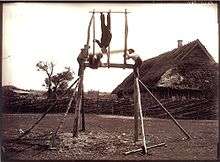Kiiking
Kiiking is a sport invented in Estonia by Ado Kosk in 1993.
In Estonian, kiik means a swing. Kiiking is a sport invented and promoted in Estonia, which involves a person making a swing gain increasingly more momentum. The goal is to pass over the spindle with the longest shafts possible.
In a kiiking swing, the swing arms are made of steel to enable a person to swing 360 degrees going over the fulcrum of the swing. A person is fastened to the swing base by his feet. To swing, the person begins to pump by squatting and standing up on the swing. The swing will gain momentum and will, by skillful pumping, take a person over the fulcrum.
Kiiking is regulated by the Estonian Kiiking Federation.
History
The practice of swinging has had an important place in Estonian culture for a long time. Traditional village swings have been prevalent in rural communal lands for centuries, places where villagers held festivities.[1] The construction of kiiking swings is radically different from village swings, however.[2]
The first kiiking swing was made by Ado Kosk in 1993. Kosk observed that it becomes more difficult to swing over the fulcrum as the arms of the swing become longer. He then designed telescoping swing arms to gradually extend the arms for an increased challenge. The person able to swing over the fulcrum with the longest swing arms is the winner. First modern kiiking swing with adjustable shafts was made in 1996.
Kiikingswing types
There are three models of swings:
- KIKI1 – shaft height 3–4m
- KIKI2 – shaft height 4–6m
- KIKI3 – shaft height 6–8m
Kiiking records
The current Estonian record of 7.15 meters was set in 2015 by Kaspar Taimsoo, who outperformed the previous 7.03 meter record set by Ants Tamme in 2012, leaving him as the Guinness World Record holder.[3] An American record of 5.66 was set by Matt Dart of Georgia in 2015. Maxwell White of Auckland set a New Zealand record of 4.83 meters in 2012.[4]
Previous Guinness records:
- 7,10 Ants Tamme, 16 September 2015
- 7,02 Andrus Aasamäe, 21 August 2004
 Indoor kiiking
Indoor kiiking- Outdoor kiiking [5]
- Kiiking in Tartu
References
- Vissel, Anu (2002). "Eestlaste kiigekultuur enne ja nüüd" (PDF). Mäetagused (in Estonian). 21: 7–84. doi:10.7592/MT2002.21.kiik. (Translated abstract available)
- Bradshaw, Luke (17 November 2017). "Estonia and its Love for Extreme Swinging". Culture Trip. Retrieved 4 August 2020.
- Estonian records 1997–2012
- "Archived copy". Archived from the original on 21 May 2011. Retrieved 21 May 2011.CS1 maint: archived copy as title (link)
- Kiiking Photos, accessed 16 June 2020
